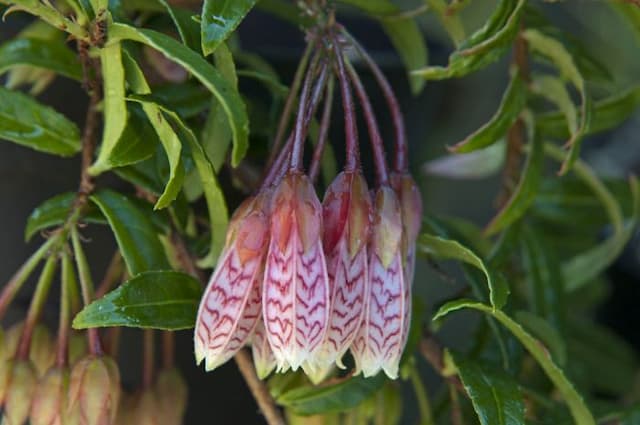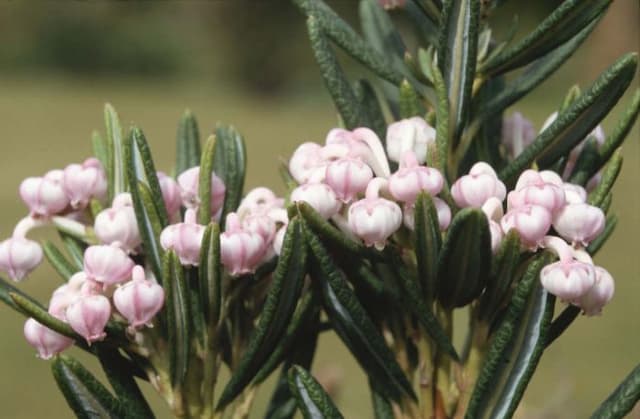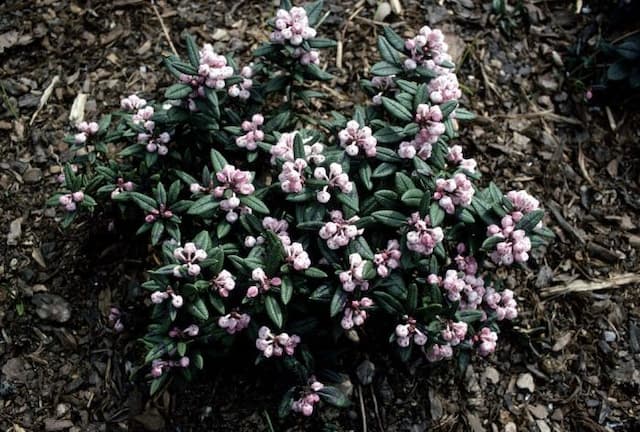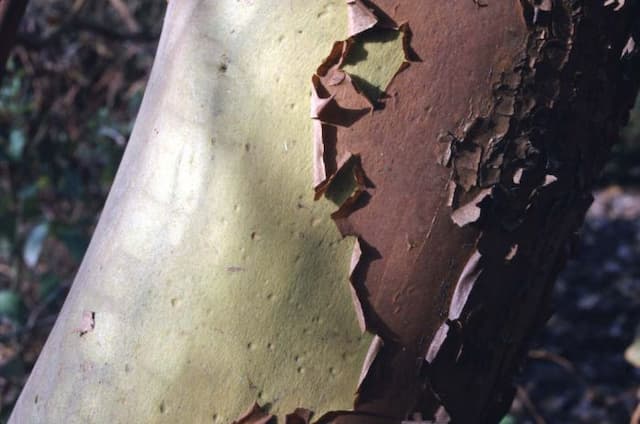Hybrid strawberry tree 'Marina' Arbutus × reyorum 'Marina'

ABOUT
'Marina' ultimately makes a small, upright tree, but is slow-growing and can remain shrub-like for many years. Red-brown peeling bark and glossy, dark green leaves to 12cm long are bronzed when young. White, urn-shaped flowers flushed with deep pink in large, hanging clusters in late summer and autumn, followed by spherical yellow then red fruit
About this plant
 Names
NamesFamily
Ericaceae
Synonyms
Marina Strawberry Tree, Marina Madrone
Common names
Arbutus 'Marina'
 Characteristics
CharacteristicsLife cycle
Perennials
Foliage type
Evergreen
Color of leaves
Dark green
Flower color
Pink
Height
25-40 feet (7.6-12.2 meters)
Spread
15-20 feet (4.6-6.1 meters)
Plant type
Tree
Hardiness zones
7-9
Native area
Cultivar
Benefits
 General Benefits
General Benefits- Ornamental Appeal: 'Marina' Madrone is known for its attractive reddish-brown bark which peels away to reveal a new layer underneath, adding visual interest throughout the year.
- Drought Tolerance: Once established, 'Marina' Madrone is quite drought-tolerant, making it ideal for water-wise gardens and xeriscaping in appropriate climates.
- Wildlife Attraction: The flowers provide nectar for bees and other pollinators, while the fruit can attract birds, contributing to local biodiversity.
- Evergreen Foliage: As an evergreen tree, it maintains its foliage throughout the year, providing consistent greenery and screening.
- Low Maintenance: It requires minimal pruning and is relatively low-maintenance compared to other ornamental trees.
- Versatility: 'Marina' Madrone can be used in a variety of landscapes, from coastal to urban settings, and can adapt to different soil types as long as they are well-draining.
- Year-Round Interest: With its changing bark, evergreen leaves, springtime flowers, and fall fruits, 'Marina' Madrone provides garden interest in all seasons.
- Shade Provider: Its canopy can offer a pleasant shade in gardens and outdoor living spaces, enhancing comfort during sunny days.
 Medical Properties
Medical PropertiesThis plant is not used for medical purposes.
 Air-purifying Qualities
Air-purifying QualitiesThis plant is not specifically known for air purifying qualities.
 Other Uses
Other Uses- Wildlife Habitat: 'Marina' Madrone provides a natural habitat for birds and small mammals with its dense foliage and branching structure.
- Bonsai: Due to its attractive bark and form, 'Marina' Madrone can be cultivated as a bonsai plant for ornamental purposes.
- Erosion Control: The root system of 'Marina' Madrone helps stabilize slopes and prevent soil erosion in landscaped areas.
- Windbreaks: Tall and sturdy, 'Marina' Madrone trees can be planted in rows to serve as windbreaks, reducing wind speed in gardens and on properties.
- Woodworking: The hard and dense wood of 'Marina' Madrone can be used for fine woodworking projects, including crafted furniture or decorative items.
- Culinary Smoking: Wood chips from 'Marina' Madrone can be used in smoking meats to impart a unique flavor.
- Educational Tool: This plant can be used in educational settings to teach about hybridization, plant biology, and conservation efforts.
- Pollinator Support: It produces flowers that are attractive to bees and other pollinators, supporting local ecosystems.
- Photography and Art: 'Marina' Madrone's unique appearance, particularly its peeling reddish bark and flowers, makes it a popular subject for photographers and artists.
- Sound Barrier: When planted densely, 'Marina' Madrone trees can help to reduce noise pollution from roads or industrial areas.
Interesting Facts
 Feng Shui
Feng ShuiThe Marina Madrone is not used in Feng Shui practice.
 Zodiac Sign Compitability
Zodiac Sign CompitabilityThe Marina Madrone is not used in astrology practice.
 Plant Symbolism
Plant Symbolism- Endurance and Survival: Arbutus 'Marina', commonly known as Marina Strawberry Tree, often symbolizes endurance and the will to survive, due to its ability to thrive in poor soils and resist drought once established.
- Beauty and Uniqueness: The striking appearance of its red, strawberry-like fruits and pinkish-brown bark can represent beauty and the celebration of unique traits.
- Immortality: With its evergreen foliage, the Marina Strawberry Tree is often linked to immortality and eternal life, staying green and vibrant throughout the year.
- Protection: Traditionally, the Strawberry Tree as a species is thought to provide protection, likely due to its sturdy nature and the ancient belief in its magical properties.
 Water
WaterThe Marina Strawberry Tree should be watered deeply, ensuring that water reaches the roots, typically once a week during the growing season. During the winter or in cooler weather, reduce watering to every two to three weeks, depending on the weather conditions and soil moisture levels. It is important to avoid overwatering; allow the soil to dry out slightly between watering sessions. An established Marina Strawberry Tree may need around 1 to 2 gallons of water, depending on the size of the tree and the environmental conditions.
 Light
LightThe Marina Strawberry Tree thrives in full sun to partial shade. The ideal spot for this plant is where it can receive at least six hours of direct sunlight daily, but it can also tolerate some shade. Avoid deep shade as it can lead to suboptimal growth and fewer flowers or fruit.
 Temperature
TemperatureThe Marina Strawberry Tree prefers a temperature range between 30°F and 100°F. It is quite tolerant of both coastal and inland climates, able to survive brief temperature dips down to about 20°F. Ideally, it performs best in a moderate climate where temperatures do not often exceed the higher end of its tolerance or drop below freezing.
 Pruning
PruningPruning the Marina Strawberry Tree helps maintain its shape and remove any dead or diseased branches. It is best pruned in late winter or early spring before new growth begins. Prune as needed to shape the tree and thin out crowded branches, which can be done every couple of years or as necessary to manage the tree's size and appearance.
 Cleaning
CleaningAs needed
 Soil
SoilThe Marina Strawberry Tree prefers well-draining soil rich in organic matter with a slightly acidic to neutral pH, around 6.0 to 7.5. A mix of loamy soil, peat moss, and perlite or sand can create an ideal environment for its roots.
 Repotting
RepottingMarina Strawberry Trees grown in pots may need repotting every 2-3 years. They should be repotted when they become root-bound or the soil is depleted.
 Humidity & Misting
Humidity & MistingMarina Strawberry Trees are tolerant of a wide range of humidity levels, but they perform best in moderate to high humidity environments, avoiding overly dry conditions.
 Suitable locations
Suitable locationsIndoor
Ensure bright light, well-drained soil, and room to grow.
Outdoor
Full sun to partial shade, protect from strong winds, well-draining soil.
Hardiness zone
8-10 USDA
 Life cycle
Life cycleSprouting begins with the germination of the 'Marina' madrone's seed, which requires a warm, moist environment to emerge. Once sprouted, the seedling develops a root system and foliage, entering the vegetative growth stage, where it rapidly increases in size and develops a woody stem. During the flowering stage, the mature 'Marina' madrone produces clusters of bell-shaped, pink or white flowers, which are pollinated by bees and other insects. Successful pollination leads to the fruiting stage, where red, berry-like fruits develop and mature, containing seeds for the next generation. As the fruits ripen, they are consumed by birds and other wildlife, which then disperse the seeds. The 'Marina' madrone can also reproduce vegetatively through root suckers, leading to the establishment of new plants nearby the parent.
 Propogation
PropogationPropogation time
Late winter-early spring
The most popular method of propagating the Marina Strawberry Tree (Arbutus × 'Marina') is through semi-hardwood cuttings. This process usually takes place during the late summer months. Cuttings should be taken from new growth that has partially matured; the wood is firm but still flexible. Typically, one would select shoots that are 4 to 6 inches long, and all but the top few leaves should be removed. The cut base of the cutting is often dipped in a rooting hormone to enhance root development, then planted in moist, well-draining potting mix. It is crucial to maintain a high humidity level around the cuttings, which can be achieved by placing a plastic cover over the pot or propagation tray. Roots generally develop within a few weeks to a couple of months, after which the new plants can be gradually hardened off before transplanting.









